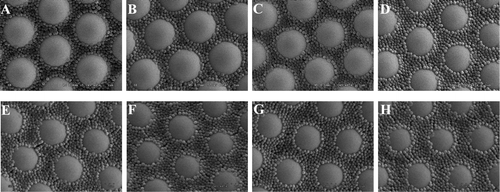| Kumnorkaew and Gilchrist report on the use of the “coffee stain” effect to simultaneously deposit controlled arrays of microparticles embedded in nanoparticles. These structures can dramatically improve the output coupling of III-Nitride LEDs. |
Reviewed by J. Alexander Liddle, National Institute of Standards and Technology
- Ee Y, Kumnorkaew P, Arif RA, Tong H, Gilchrist JF, and Tansu N. 2009. Light extraction efficiency enhancement of InGaN quantum wells light-emitting diodes with polydimethylsiloxane concave microstructures. Optics Express 17(16): 13747-13757. DOI: 10.1364/OE.17.013747
- Kumnorkaew P, and Gilchrist JF. 2009. Effect of Nanoparticle Concentration on the Convective Deposition of Binary Suspensions. Langmuir 25(11): 6070-6075. DOI: 10.1021/la804209m
There has been an enduring interest in particle deposition from colloids because of the technique’s potential for providing a low-cost means of patterning large areas with small feature sizes—one of the fundamental issues in nanomanufacturing. Colloidal particles can be produced in bulk, have uniform size, and exhibit an enormous range of desirable properties. Depending on their size and composition, they have applications in areas as diverse as catalysis, photonics, superhydrophobic surfaces, and bio-compatible materials.
Particles can be deposited from a liquid suspension in many different ways—most simply from a drying liquid drop. Evaporation from the drop transports the particles to the liquid-substrate contact line and the particles accumulate there, known as the “coffee stain” effect. Recent work has investigated methods including deposition by sedimentation, by slowly drawing a substrate out of a suspension and by Langmuir-Blodgett techniques. However, for a high-throughput manufacturing process, passing a web underneath a particle suspension held in place by a doctor blade provides the opportunity to control the deposition rate precisely, enabling the formation of uniform monolayers of close-packed particles. Such a structure can be used to improve the efficiency of LEDs.
The large mismatch in refractive index between the LED material and air means that only a narrow cone of the light produced in the body of the device can couple out. In an uncoated GaN device, for example, only 4% of the photons produced can escape. While standard, planar anti-reflective coatings minimize Fresnel reflection losses for light emitted within the escape cone, they do nothing to increase the size of that cone. However, an array of microlenses can increase the size of the escape cone by almost a factor of 2.
Earlier this year, Ee et. al. demonstrated that such an array could be readily produced by depositing silica microspheres from a suspension and could improve the output coupling efficiency dramatically. Further improvements may be obtained by combining the array with a graded index coating. The authors fabricated such a microlense array by depositing a monolayer of polystyrene (PS) microspheres, followed by a second layer of silica microspheres, and then heating them above the glass transition temperature of the PS to 140° C to create silica microspheres embedded in a PS film. Careful optimization of the silica sphere size and the PS layer thickness led to improvements in output coupling efficiency of up to 2.7 times.

More recently, Kumnorkaew and Gilchrist reported on a simple, high-throughput technique for producing the desired structure using only a single deposition step. In their experiments they used a suspension comprising the same silica microspheres as before, but this time they added PS nanospheres to the suspension. A concentrated suspension of particles (20% volume fraction of silica and up to 16% volume fraction of PS) was held in contact with a moving substrate using a doctor blade. Deposition occurs as a result of evaporation of the fluid contact line. By systematically studying the effect of nanoparticle concentration on the deposition process, they were able to identify a relatively large operating window in which they could produce a close packed array of silica microspheres embedded in PS nanospheres. This allowed them to control the thickness of the PS layer formed when the PS nanospheres were melted.
The authors have demonstrated a method for the ordered deposition of binary micro- and nanoparticle suspensions that can produce relatively sophisticated micro-optical structures. Exploiting the “coffee stain” effect, this technique will also have applications in many other areas.
Image reproduced with permission from Kumnorkaew P, and Gilchrist JF. 2009. Effect of Nanoparticle Concentration on the Convective Deposition of Binary Suspensions. Langmuir 25(11): 6070-6075. DOI: 10.1021/la804209m. Copyright 2009 American Chemical Society.
This work is licensed under a Creative Commons Attribution-NonCommercial 3.0 Unported.
